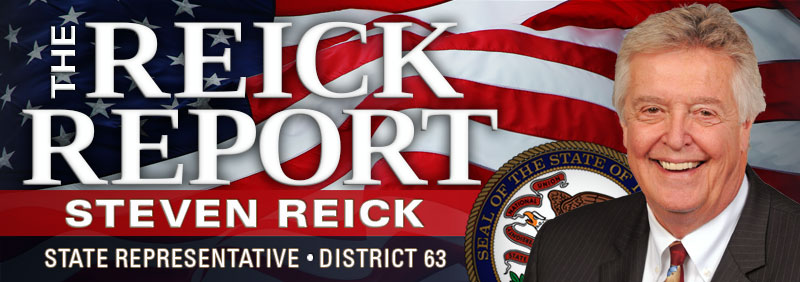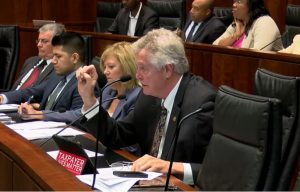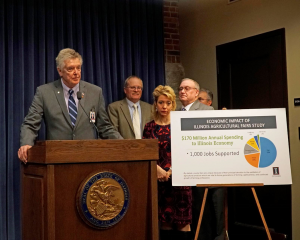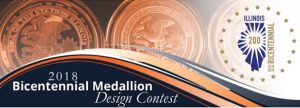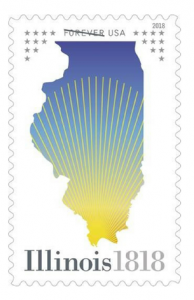Legislators finished a busy week in Springfield on Thursday, as dozens of House Bills moved through the committee process and several pieces of legislation made their way to the floor of the House for full debates and votes. As is typical this time of the year, we spent a great deal of time in committees so members’ bills could be heard prior to the April 13 committee action deadline. Lawmakers are now back in their home districts for four weeks to tend to local constituent needs. We return to Springfield on Monday, April 9.
Reick Chosen to Serve on House Higher Education Committee
Commission on Government Forecasting and Accountability (COGFA) Releases Reveneue Estimate for Fiscal Year 2019
COGFA, the nonpartisan accounting and State budget-forecasting arm of the Illinois General Assembly, has published its initial estimate of Illinois general revenues for Fiscal Year (FY) 2019. For the fiscal year that will start on July 1, 2018, the current forecast is for receipts to continue to increase over FY 2018 levels, albeit at a slower pace than the increase enjoyed in FY 2017. General funds revenues are expected to increase by approximately 3.0% in FY19 over FY18, exclusive of transfer lines. This equates to an increase of $1,029 million in FY19 general funds revenues, from an expected $34,804 million in FY18 to $35,833 million in FY19. While this is a healthy increase, it is once again not sufficient for the State of Illinois to pay its mandated share of the ever-rising cost of medical care for Medicaid line items, cover actuarially required pension cost increases, and pay back old bills in FY19.
My hope is that the legislators in the House of Representatives utilize this data and approve an agreed revenue estimate that will guide budget discussions. The Constitutions requires a balanced budget, and we must agree on projected revenues before we begin allocating monies to be spent.
House Takes Action in Wake of Mass Shooting at Florida School
Illinois House Passes Bills Intended to Assess Hospitals for Federal Healthcare Funding
Under current federal law, part of Illinois’ federal funding for health care is raised through an assessment process. Funds are collected from Illinois hospitals and used as seed money to request matching funds from Washington, D.C. SB 1573 and SB 1773 allow this assessment program to continue with cash flows reflecting ongoing changes in health care and the health care professions. At the end of February, the House passed SB 1573 by a vote of 110-0-1 and passed SB 1773 by a vote of 107-0-0.
Passage of these two bills was necessary because the current 2008 hospital assessment program will sunset on June 30, 2018. Enactment of this legislation will bring $3.5 billion in federal money into our State to support its healthcare infrastructure. Through a six-month-long cycle of meetings chaired on a bipartisan basis by members of the Illinois General Assembly, Illinois hospitals agreed to the specifications of the new assessment system. One key element of the new assessment system is a program of enhanced funding for challenged Illinois hospitals, including rural and inner-city safety-net hospitals. Of the money generated by these measures, 58% is expected to go to safety-net hospitals.
Illinois Praised as Good Location for Future Job Creation
The rating was bestowed by “Site Selection” Magazine, a CEO-oriented periodical and database that compiles information on the relative activities of U.S. locations for business relocation and job growth. Illinois ranked third in the number of new and expanded facilities per capital tracked by the periodical database, in a ranking called the “Governor’s Cup” by the magazine.
Commentators said Illinois was honored for its transportation infrastructure and relatively affordable real estate. More than 400 new and expanded facilities were tracked moving to or expanding in greater Chicago, exclusive of Lake County, in the 2017 Governor’s Cup rankings. This benchmark, which made greater Chicago the #1 U.S. metropolitan area tracked by “Site Selection” with a population of 1 million or more, powered Illinois’ overall standings. However, Illinois’ strength was not limited to greater Chicago. Three Illinois areas defined by the U.S. Census Bureau as “micropolitan areas,” population centers in predominantly rural environments with a population between 10,000 and 50,000, also scored highly. Strong Illinois micropolitan areas were Ottawa-Peru, Effingham, and Rochelle. All three regions are places where transcontinental railroad service comes together with two or more U.S. Interstate highways.
Mark Your Calendar for Upcoming Summer & Fall Events in the 63rd District
- Wednesday, June 5: Understand Your Property Tax Bill: 6:30 PM until 8:30 PM, McHenry County Administration Building, 667 Ware Road, Upstairs Conference Rooms A & B, Woodstock
- Thursday, June 28: Senior Fair: 10:00 AM until 12:00 Noon, Johnsburg High School, 2002 W. Ringwood Road, Johnsburg
- Saturday, August 18: Joint Document Shredding/Canned Food Drive (for Woodstock Food Pantry): 9:00 AM until 12:00 Noon, 1072 Lake Avenue (Rear lot of the Reick Office), Woodstock
- TBA: Women’s Self Awareness/Self Defense Class
Bicentennial Medallion Art Contest Underway in Illinois
Illinois Commemorative Stamp Released
The figures, compiled by the federal Centers for Disease Control and Prevention (CDC), used July 2016 as a base and September 2017 as an endpoint. The numbers, based on surveys of emergency room (ER) personnel nationwide, were compiled nationwide and broken out by state. During this 14-month period, more than 142,000 patients came or were brought to ERs nationwide for emergency treatment of opiate overdoses.
Overdose drugs include heroin, fentanyl, OxyContin, and other dangerous medications that utilize the painkilling powers of opium. Patients who take opiates are in serious danger of overdosing because of the known tendency of the human neurological system to build up resistance, called “tolerance,” to opiate pain relievers. As time goes by the patient must take more and more opiates to achieve the same outcome. The Illinois General Assembly has taken many steps in recent years to make it more difficult to buy opiate painkillers through prescription pharmacies; however, some patients are responding to these policy changes by increasing their demands for opiates through the illegal drug market. The Controlled Substances Act is the State statute that tries to help law enforcement stamp out illegal opium-based drugs in Illinois.
Recent data shows that nearly 1,950 Illinois residents died from opioid overdoses in Illinois during the period studied by the CDC. Other U.S. states are also seeing sharp increases in opioid incidents and opioid-related deaths.
